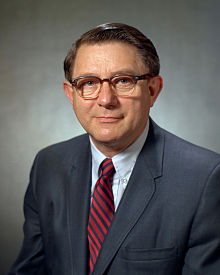Abe Silverstein
| Abraham Silverstein | |
|---|---|

Dr. Abe Silverstein
|
|
| Born | September 15, 1908 Terre Haute, Indiana |
| Died | June 1, 2001 (aged 92) Fairview Park, Ohio |
| Nationality | American |
| Occupation | Engineer |
| Awards | Daniel Guggenheim Medal (1997) |
Abraham "Abe" Silverstein (September 15, 1908 – June 1, 2001) was an American engineer who played an important part in the United States space program. He was a longtime manager at the National Aeronautics and Space Administration (NASA) and its predecessor, the National Advisory Committee for Aeronautics (NACA). He was instrumental in the planning of the Apollo, Ranger, Mariner, Surveyor, and Voyager missions, and named the Apollo program after the Greek and Roman God.
Born in Terre Haute, Indiana, Silverstein earned a B.S. in mechanical engineering (1929) and a Master of Engineering (1934) from the Rose Polytechnic Institute in his hometown.
He was hired by NASA's predecessor NACA in 1929 at the Langley Aeronautical Laboratory as an aerodynamicist to work on the design of the Altitude Wind Tunnel to be built in Cleveland, Ohio as the Lewis Laboratory (later, the Lewis Research Center, and now known as Glenn Research Center). While at Langley, he directed important aerodynamic research which led to increased high-speed performance of most of the combat aircraft of World War II. In 1944 he joined the High-Speed panel and advocated the supersonic wind tunnel, completed in 1949. Following World War II, Silverstein was responsible for the conception, design, and construction of America's first supersonic propulsion wind tunnels. The investigations in these facilities greatly contributed to the development of supersonic aircraft. He also directed research in propulsion aerodynamics in the Altitude Wind Tunnel that led to significant improvements in both reciprocating and early turbojet aircraft engines. He also pioneered research on large-scale ramjet engines.
...
Wikipedia
